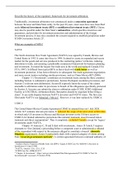Describe the history of the regulatory framework for investment arbitration.
Traditionally, investment arbitration was commenced under a concession agreement
between Investor and State/State entity. In the past 20 years, most cases have now been filed
under bilateral investment treaty (BIT) or multilateral investment treaty (MIT). Claims
may also be possible under the Host State’s national law, which specifies incentives and
guarantees, and provides for investment protection and administration of the foreign
investment process. It may also constitute the consent required to establish jurisdiction under
ICSID Convention Article 251.
What are examples of MITs?
NAFTA
The North American Free Trade Agreement (NAFTA) was signed by Canada, Mexico and
United States in 1992. It came into force in 1994. It aimed to create an expanded and secure
market for the goods and services produced in the contracting parties’ territories, reducing
distortions to trade, and ensuring a predictable commercial framework for business planning
and investment. It created the largest free trade area in the world and replaced Canada-USA
FTA (1987). It differed from typical BITs in that it dealt with trade issues as well as
investment protection. It has been referred to in subsequent free trade agreement negotiations
and more recent treaties including similar provisions, such as China-Mexico BIT (2008).
Chapter 11 (‘Investment’) constitutes an investment treaty among the three countries
including Section A (substantive protections), Section B (dispute resolution provisions), and
Section C (relevant term definitions). Section B expressly limits the scope of the claims
amenable to arbitration under its provisions to breach of the obligations specifically protected
by Section A. Investor can submit the claim to arbitration under ICSID, ICSID Additional
Facility or UNCITRAL Arbitration Rules. But parties should try negotiate before filing a
claim2. It can settle disputes between NAFTA investors and NAFTA states. The first case
filed under NAFTA was Metaclad v Mexico3. However, it was later replaced by USMCA.
USMCA
The United States-Mexico-Canada Agreement (USMCA) entered force on 1 July 2020.
Article 34.5 contains relevant provisions. It reduced the scope of investor-state arbitration,
in which only US investors in Mexico and Mexican investors in the US have access to
USMCA for limited substantive protections like national treatment, most favoured nation
treatment and direct expropriation4. Thus it completely excluded Canada except for ‘legacy’
investments under NAFTA.
Chapter 14 Annexes C, D and E deal with investments. Annex D Article 5 requires
claimants to ‘first [initiate] a proceeding before a competent court or administrative tribunal
of the respondent with respect to the measures alleged to constitute a breach’ (domestic
litigation requirement). Annex E particularly deals with a special category of claims arising
from ‘covered government contracts’ (‘a written agreement between a national authority of
1
Southern Pacific Properties (Middle East) Ltd [SPP] v Egypt, ICSID Case No ARB/84/3, Decision on
Jurisdiction (14 April 1988)
2
NAFTA, Articles 1116, 1118, 1120
3
ICSID Case No. ARB(AF)/97/1
4
‘Chapter 14 Investment’ <https://ustr.gov/sites/default/files/files/agreements/FTA/USMCA/Text/14-
Investment.pdf> accessed 15 October 2018]
, an Annex Party and a covered investor of the other Annex Party, on which the covered
investor relies in establishing or acquiring a covered investment in a covered sector’).
CAFTA
US concluded Central American Free Trade Agreement (CAFTA), similar to NAFTA, with
certain Central American nations. It entered into force on 1 March 2006. CAFTA includes
Costa Rica, El Salvador, Guatemala, Honduras, Nicaragua, US. Dominican Republic joined
negotiations at a later stage.
Chapter 10 (‘Investment’) borrows provisions from Chapter 11 and US Model BIT.
Claimant must give at least 90 days’ notice of a claim before seeking to initiate arbitration,
and no claim may be brought before six months have passed since the events giving rise to
the claim (referred to as a 'cooling off' period). Claims may be brought under ICSID, ICSID
Additional Facility or UNCITRAL Rules. Lex arbitri covers conduct of the arbitration
(Article 10.20), transparency (Article 10.21) and expert reports (Article 10.24).
ASEAN Agreement
ASEAN Comprehensive Investment Agreement comprises Brunei, Cambodia, Indonesia,
Laos, Malaysia, Myanmar, the Philippines, Singapore, Thailand and Vietnam. It came into
effect on 29 March 2012 and replaced ASEAN Agreement for the Promotion and Protection
of Investments of 15 December 1987. Investment treaty arbitrations can take place at any
regional centre for arbitration in ASEAN like SIAC, in addition to ICSID and UNCITRAL.
There was only one investment case taken under this earlier treaty and the tribunal declined
jurisdiction5. It attempted progressive liberalisation of investment regimes of member
states, enhanced protection to investors of all Member States and their investments,
improvement of transparency and predictability of investment
rules/regulations/procedures conducive to increased investment, joint promotion of the region
as an integrated investment area, and cooperation to create favourable conditions for
investment by Member State investors in other Member States’ territories.
Article 29 provides that dispute resolution provisions apply to ‘an investment dispute
between a Member State and an investor of another Member State that has incurred loss or
damage by reason of an alleged breach of any rights conferred by this Agreement with
respect to the investment of that investor’. Investor can submit the claim to disputing Member
State’s court/administrative tribunal, ICSID, UNCITRAL Arbitration Rules, Regional Centre
for Arbitration at Kuala Lumpur, other regional centre for arbitration in ASEAN, or as agreed
any other arbitration institution.
Articles 31 and 32 require investors to seek resolution through prior ‘consultations
and negotiations’. If not resolved by the host State within 180 days of receiving a request
for such consultations, disputes may then be submitted to arbitration.
ECT
Energy Charter Treaty (ECT) was opened for signature in 1994. It was negotiated quickly
given the strategic and economic significance of the energy sector. Signatories include all
countries of the Former Soviet Union, central and eastern European States, Japan, Australia,
the European Union and its individual Member States (not US, Middle East, South America).
Some states like Australia, Belarus, Norway and Russia have only signed, not ratified, the
Treaty. Russia announced it would not intend to become a contracting party in 2009. Article
5
Yaung Chi v Myanmar ASEAN I.D. Case No. ARB/01/1




